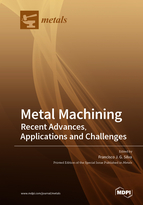Metal Machining—Recent Advances, Applications and Challenges
A special issue of Metals (ISSN 2075-4701). This special issue belongs to the section "Metal Casting, Forming and Heat Treatment".
Deadline for manuscript submissions: closed (28 February 2021) | Viewed by 41456
Special Issue Editor
Interests: tribology; coatings; manufacturing processes
Special Issues, Collections and Topics in MDPI journals
Special Issue Information
Dear Colleagues,
Machining remains one of the most important manufacturing processes in the worldwide context, being used every time surface finishing needs to be almost perfect due to contact with other parts. Machining processes have evolved significantly, as have the tools associated with them. The optimization of machining parameters has been a largely studied issue but remains a challenge, because every day, new tool shapes are being created, as well as new coatings used in their surfaces. Further, the machining trajectories in CNC machines have experienced a deep evolution. Thus, there are several interesting topics going through developments every day. This Special Issue intends to accumulate the most recent advances through original high-quality works that are able to disseminate the new evolutions and trends in machining processes, from the conventional to the most advanced processes.
Prof. Dr. Francisco J. G. Silva
Guest Editor
Manuscript Submission Information
Manuscripts should be submitted online at www.mdpi.com by registering and logging in to this website. Once you are registered, click here to go to the submission form. Manuscripts can be submitted until the deadline. All submissions that pass pre-check are peer-reviewed. Accepted papers will be published continuously in the journal (as soon as accepted) and will be listed together on the special issue website. Research articles, review articles as well as short communications are invited. For planned papers, a title and short abstract (about 100 words) can be sent to the Editorial Office for announcement on this website.
Submitted manuscripts should not have been published previously, nor be under consideration for publication elsewhere (except conference proceedings papers). All manuscripts are thoroughly refereed through a single-blind peer-review process. A guide for authors and other relevant information for submission of manuscripts is available on the Instructions for Authors page. Metals is an international peer-reviewed open access monthly journal published by MDPI.
Please visit the Instructions for Authors page before submitting a manuscript. The Article Processing Charge (APC) for publication in this open access journal is 2600 CHF (Swiss Francs). Submitted papers should be well formatted and use good English. Authors may use MDPI's English editing service prior to publication or during author revisions.
Keywords
- Machining process
- Machining tools
- Tools behavior
- Tools coatings behavior
- Tools lifespan
- Chip formation
- Machining parameters optimization
- Tools geometry optimization
- Machining simulation
- CNC Trajectories optimization
- Turning
- Milling
- Drilling
- Wire EDM
- EDM
- Hybrid machining
- Machining in an Industry 4.0 context
- Machining in Smart Manufacturing
Related Special Issue
- Machining: State-of-the-Art 2022 in Metals (12 articles)






